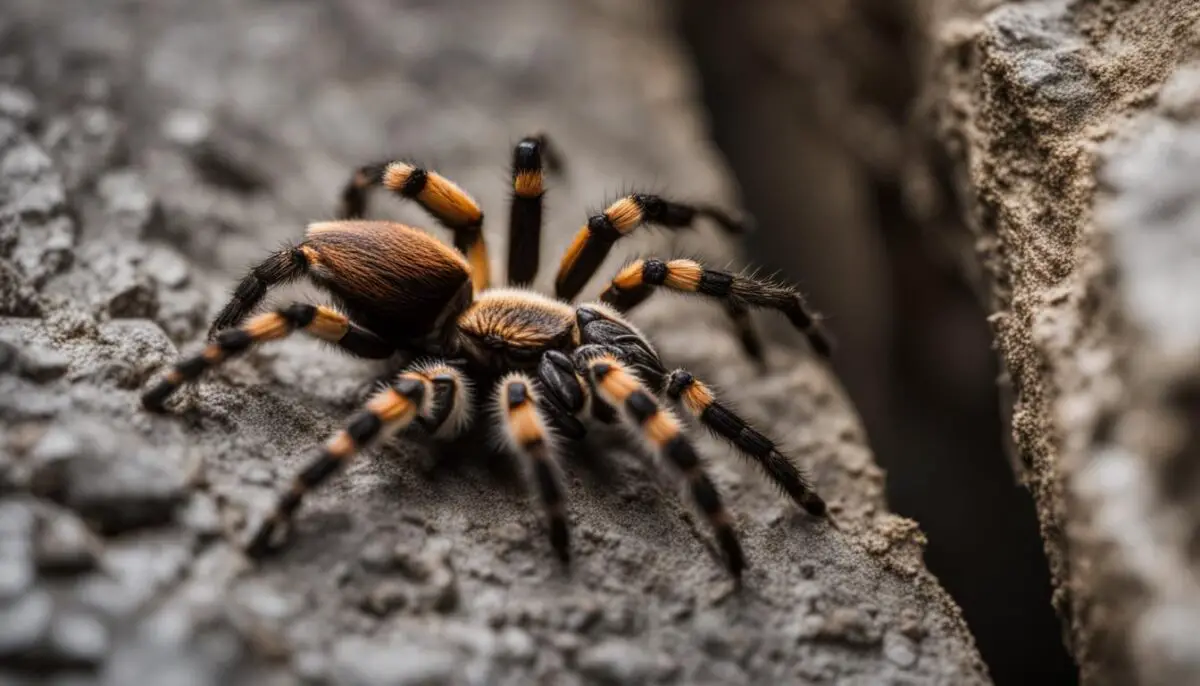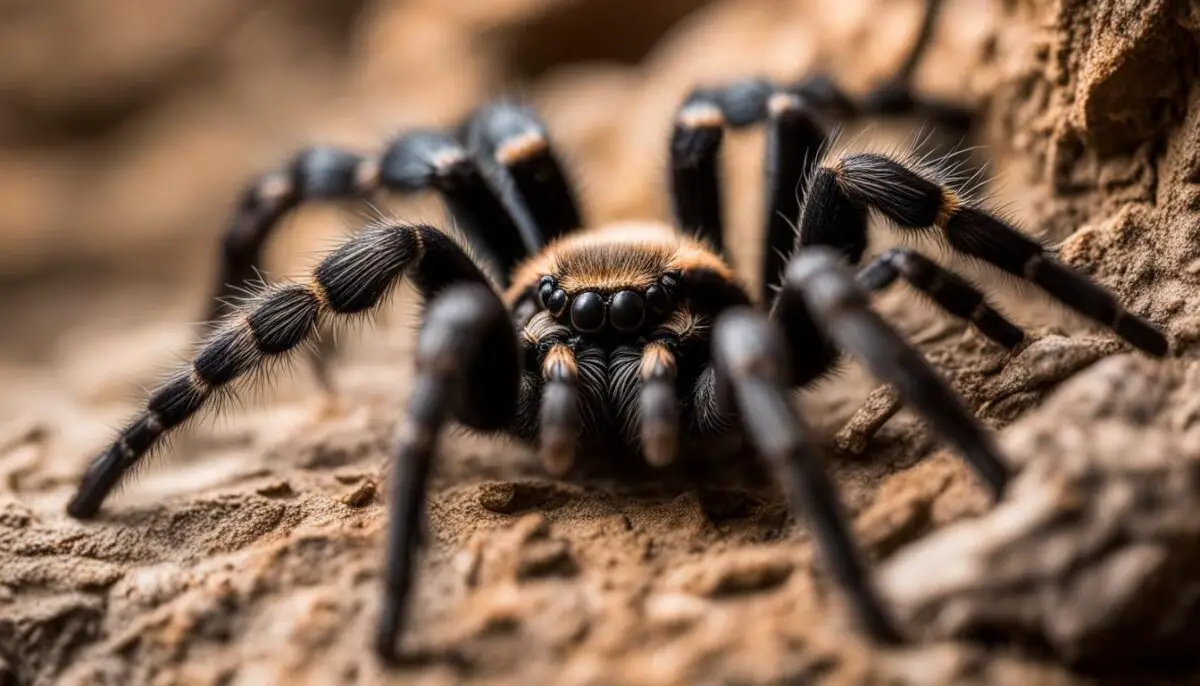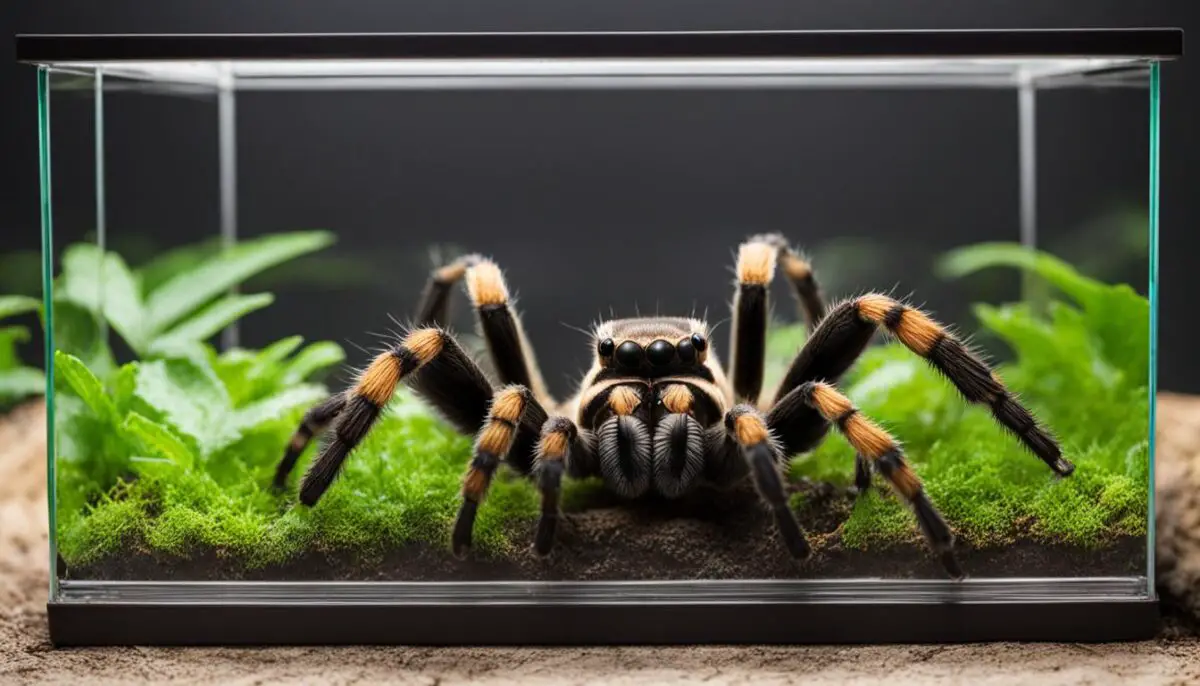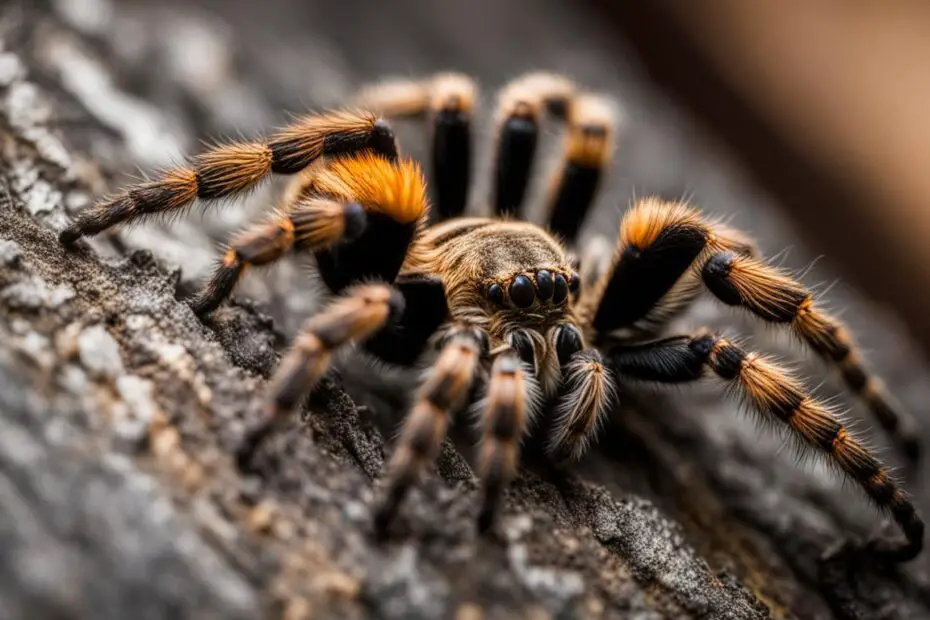Are you curious about whether tarantulas have the ability to climb walls? In this article, we will explore the climbing capabilities of these fascinating creatures and uncover the truth behind their wall-climbing tendencies. Whether you are a tarantula owner or simply intrigued by their behavior, read on to learn more!
Tarantulas, known for their unique characteristics and behaviors, are generally good climbers. Even though not all tarantulas prefer to climb glass walls, they do possess the ability to do so. Their climbing capabilities enable them to cling to smooth surfaces using silk-shooting feet, which produce small amounts of sticky silk. This silk anchors them down and prevents them from falling. Additionally, tarantulas have small claws on their legs and tiny hairs called setules that aid in maintaining a grip on smooth surfaces.
Keep in mind that it is essential to have a secure lid on a tarantula enclosure to prevent any potential escapes through glass walls. Now, let’s dive deeper into the world of tarantula climbing!
Key Takeaways:
- Tarantulas can climb smooth surfaces like glass walls using silk-shooting feet, claws, and setules.
- Not all tarantulas prefer to climb walls, but they have the ability to do so.
- A lid on the tarantula enclosure is crucial to prevent escape through glass walls.
- Climbing behavior in tarantulas can be influenced by various factors such as substrate dislike, pest avoidance, or lack of hiding places.
- Understanding tarantula climbing behavior helps provide appropriate housing and conditions for these fascinating creatures.
Can Tarantulas Climb Walls
How Do Tarantulas Climb Glass Walls?
Tarantulas are fascinating creatures with unique climbing abilities. They have evolved specific adaptations that allow them to navigate and conquer smooth surfaces, including glass walls. With their silk-shooting feet, tarantulas can produce sticky silk threads that anchor them to the surface, preventing them from falling. These silk threads act as a safety line, providing stability and grip as the tarantula moves.
In addition to their silk-shooting feet, tarantulas possess setules, which are tiny hairs that cover their legs. These setules create a weak electric attraction with the surface, further enhancing their ability to cling to smooth surfaces. The combination of silk threads and setules allows tarantulas to confidently climb glass walls, even hanging upside down if necessary. can tarantulas climb walls
The legs of tarantulas also play a crucial role in their climbing abilities. They have small claws that help them grip onto surfaces, providing additional support and stability during their ascents. These leg adaptations, along with their silk-shooting feet and setules, make tarantulas highly skilled climbers, capable of maneuvering on various surfaces, including glass walls.
Tarantula Leg Adaptations for Climbing
Tarantulas have evolved specific leg adaptations that aid in their climbing abilities. Their legs are long and muscular, allowing for efficient movement and grip on different surfaces. The small claws on their legs act as hooks, enabling them to secure themselves to the surface as they climb. tarantula wall climbing
Furthermore, the setules present on their legs create a weak electric attraction with the surface, helping them maintain their grip. This combination of leg adaptations, along with the silk-shooting feet, allows tarantulas to confidently navigate and conquer glass walls, showcasing their remarkable climbing capabilities.
Reasons Why Tarantulas Climb
Tarantulas exhibit climbing behavior for various reasons, providing insight into their unique behaviors and needs. Understanding these motivations can help tarantula keepers provide appropriate care and create an enriching environment for their eight-legged pets. do tarantulas have the ability to climb walls
1. Climbing Due to Substrate Dislike
One common reason why tarantulas climb is to escape an unfavorable substrate. Tarantulas may dislike certain types of substrate material or find it too wet. In such cases, they may climb to higher surfaces to avoid the substrate and seek a drier or more suitable environment. tarantula wall climbing characteristics
2. Climbing to Escape Moist Substrate
In addition to disliking wet substrate, tarantulas may also climb to escape excessively moist conditions in their enclosure. Moisture levels are crucial for tarantula health, and climbing allows them to find drier areas within the enclosure or seek out better ventilation. climbing behavior of tarantulas
3. Climbing to Avoid Pests in the Enclosure
Another driving factor for tarantula climbing is the presence of pests or excessive reproduction of other bugs in the enclosure. Tarantulas may climb to higher surfaces to avoid these pests, creating a sense of security and reducing the risk of being bothered or harmed by unwanted intruders.
4. Climbing Due to Lack of Hiding Places
Tarantulas require suitable hiding places within their enclosure to feel secure. If a tarantula does not have adequate hiding spots, it may resort to climbing as a way to find alternative shelter or explore its surroundings in search of a suitable hiding place. tarantula climbing capabilities
5. Climbing as a Form of Exploration
Climbing behavior in tarantulas can also be a form of exploration. Tarantulas are curious creatures and climbing allows them to investigate their environment, discover new areas, and satisfy their natural instincts to explore their surroundings.
6. Climbing to Search for Food or Water
Tarantulas may climb in search of food or water sources. By climbing higher surfaces, they can potentially locate prey items or find water droplets for hydration. This behavior is driven by their natural instincts to search for sustenance and survive in their habitat. wall-climbing tendencies of tarantulas

Tarantula Climbing and Environmental Factors
When it comes to tarantulas and their climbing behavior, several environmental factors can influence their tendency to climb. Understanding these factors can help tarantula keepers create suitable and enriching habitats for their eight-legged friends. tarantula wall climbing techniques
One important factor is the type of substrate provided in the tarantula enclosure. Tarantulas may climb if they dislike the substrate material or if it is too wet for their liking. They prefer clean and tidy environments, so the presence of mold or excessive moisture in the substrate can prompt them to climb in an attempt to find drier and more comfortable areas.
Another factor that can trigger climbing behavior is the availability of suitable hiding places. Tarantulas are naturally inclined to seek out hiding spots for security and protection. If an enclosure lacks proper hiding places, tarantulas may resort to climbing as a way to find a safe and secluded area. can all tarantula species climb walls
Additionally, tarantulas may climb due to hunger or thirst. When searching for food or water, they may explore their surroundings and climb in their quest to satisfy their needs. Providing adequate food and water sources within the enclosure can help alleviate this climbing behavior caused by hunger or thirst.
Table: Environmental Factors Affecting Tarantula Climbing
| Factors | Influence on Climbing Behavior |
|---|---|
| Substrate | Dislike for substrate material or excessive moisture can prompt climbing behavior. |
| Hiding Places | Lack of suitable hiding places can encourage climbing behavior. |
| Hunger or Thirst | Tarantulas may climb to search for food or water sources. |
By considering these environmental factors and addressing them in the tarantula’s habitat, keepers can provide a conducive environment that minimizes unnecessary climbing while promoting the natural behaviors and well-being of their tarantulas.
Factors Affecting Tarantula Climbing Abilities
Tarantulas, like other creatures, have varying abilities when it comes to climbing. Different tarantula species exhibit different climbing capabilities based on their natural adaptations and preferences. Arboreal tarantulas, for example, are inherently skilled climbers due to their longer legs and lighter body weight. These adaptations enable them to maneuver effortlessly in their native tree-dwelling habitats. On the other hand, terrestrial tarantulas may not climb as frequently or skillfully as their arboreal counterparts, but they still possess the ability to scale smooth surfaces like glass walls.
Arboreal tarantulas have evolved to navigate vertical surfaces using their silk-shooting feet and setules, fine hairs that create an electric attraction with the surface. This unique combination of silk and setules allows them to cling securely to tree trunks and branches. Terrestrial tarantulas, while lacking the same level of adaptations, can still climb glass walls using their silk-shooting feet, setules, and small claws on their legs. These characteristics provide enough grip and stability for them to navigate smooth surfaces.
It is important to note that the climbing abilities of tarantulas may also be influenced by factors such as age, size, and overall health. Younger tarantulas may be more active climbers, while larger, heavier individuals might rely more on their silk-shooting feet and setules for support. Environmental factors like humidity levels and temperature can affect a tarantula’s climbing behavior as well. Providing the optimal conditions and enclosure setup that mimic their natural habitats is crucial to promoting their well-being and facilitating their climbing tendencies.
Overall, while climbing abilities may vary between tarantula species, they all possess adaptations that allow them to scale smooth surfaces. Whether they are gracefully navigating the heights of trees or confidently scaling glass walls, tarantulas’ climbing capabilities are a testament to their remarkable adaptability and survival strategies.
Table: Tarantula Climbing Abilities
| Tarantula Species | Climbing Adaptations |
|---|---|
| Arboreal Tarantulas | – Longer legs that aid in climbing – Lighter body weight for agile movement – Silk-shooting feet for secure attachment to surfaces – Setules for enhanced grip – Fine hairs that create an electric attraction with the surface |
| Terrestrial Tarantulas | – Silk-shooting feet for gripping smooth surfaces – Setules for additional adhesion – Small claws on legs for stability |
The Myth of Tarantulas Getting Stuck on Glass Walls
There is a common misconception that tarantulas can get stuck on glass walls. However, this is not true. Tarantulas have impressive climbing capabilities and can grip onto smooth surfaces without any risk of getting trapped. Their unique adaptations, such as silk-shooting feet, setules, and claws, enable them to cling to glass walls securely.
“Tarantulas are fascinating creatures that have evolved specific mechanisms to climb various surfaces. Their silk-shooting feet produce sticky silk that anchors them to the glass, while setules and claws provide additional grip. It’s important to understand that tarantulas may climb glass walls, but it is not their preferred behavior. They usually prefer to keep their feet on the ground or climb other objects.”
These natural climbing abilities are essential for tarantulas in the wild, allowing them to explore their environment, search for food and water, and escape potential threats. While it’s important to have a lid on a tarantula enclosure to prevent escapes, there is no need to worry about them getting stuck on the glass walls.

Debunking the Myth:
- Tarantulas can climb glass walls without getting stuck.
- They have silk-shooting feet, setules, and claws that help them grip onto smooth surfaces.
- While they can climb glass, it is not their preferred behavior.
- Having an escape-proof enclosure with a secure lid is still important to prevent potential escapes.
Understanding the truth behind this myth helps tarantula keepers provide better care and housing for their eight-legged pets. By ensuring a safe and comfortable environment, tarantulas can thrive and display their natural climbing behaviors without any risk of getting stuck.
When Tarantulas Cannot Climb Glass Walls
While tarantulas have the ability to climb glass walls, there may be instances where they are unable or unwilling to do so. Not all tarantulas prefer to climb glass and may choose to stay on the ground or climb other objects. The climbing limitations in tarantulas can vary depending on factors such as the species, health, humidity levels, and temperature.
Some tarantulas may not have the physical adaptations necessary for efficient climbing, especially terrestrial species that are better suited for life on the ground. These species may have shorter legs and a heavier body weight, making it more difficult for them to climb smooth surfaces like glass walls. Additionally, factors such as overall health and strength can also affect a tarantula’s climbing abilities.
Humidity levels and temperature can also play a role in a tarantula’s willingness or ability to climb. If the enclosure is too dry or the temperature is too high, tarantulas may prefer to stay closer to the ground where conditions are more favorable. It is important to provide the optimal environmental conditions for tarantulas to ensure their well-being and to encourage natural behaviors like climbing.
Possible Reasons for Tarantulas Not Climbing Glass
- Lack of physical adaptations for efficient climbing
- Species preference for staying on the ground or climbing other objects
- Overall health and strength of the tarantula
- Inappropriate humidity levels or high temperatures
| Factors | Possible Effects on Climbing Ability |
|---|---|
| Species | Different species may have varying climbing capabilities |
| Health | Sick or weak tarantulas may have limited climbing abilities |
| Humidity Levels | Dry conditions may discourage climbing behavior |
| Temperature | Extreme temperatures can impact climbing tendencies |
Understanding the limitations and preferences of tarantulas when it comes to climbing glass walls is crucial for providing appropriate housing and care. By creating a suitable environment with proper humidity levels, temperatures, and enriching the enclosure with climbing structures, tarantula keepers can provide a more conducive space for their pets. It is important to respect the natural behaviors and needs of tarantulas while ensuring their safety by providing an escape-proof enclosure with a secure lid.

A securely enclosed tarantula habitat also helps protect your tarantula from potential hazards outside of the enclosure. By providing an escape-proof environment, you can ensure that your tarantula is safe from predators, other pets, or accidental damage. It also gives you peace of mind knowing that your tarantula is secure and cannot wander off.
Remember to always keep the enclosure closed and locked when you are not around to supervise. This prevents the tarantula from discovering weaknesses in the lid or attempting to push it open. By being proactive in providing an escape-proof enclosure, you can create a safe and comfortable habitat for your tarantula, ensuring their well-being and minimizing the risk of escape.
Tips for Proper Tarantula Care and Keeping
Proper care and keeping of tarantulas is essential to ensure their well-being. Here are some tips to help you provide the best care for your eight-legged friends:
- Provide hiding places: Tarantulas need hiding places in their enclosure to feel secure. For terrestrial species, you can use pieces of wood, bark, or artificial hides. Arboreal tarantulas will benefit from vertical elements like cork bark or branches.
- Maintain optimal substrate: Choose a substrate that suits your tarantula’s species and preferences. Avoid substrates that are too moist, as they can lead to mold and climbing behavior. Regularly monitor and adjust the moisture levels, keeping it slightly damp for most species.
- Keep a clean enclosure: Regularly clean your tarantula’s enclosure to prevent mold, mites, and other pests. Remove any uneaten prey items and feces. Keeping the enclosure clean and tidy will help create a healthy and stress-free environment for your tarantula.
Remember, tarantulas are sensitive creatures, so it’s important to provide a suitable environment that mimics their natural habitat. By following these tips, you can ensure the well-being of your tarantula and enjoy their fascinating behaviors.

Create a table for different tarantula species and their preferred substrate:
| Tarantula Species | Preferred Substrate |
|---|---|
| Grammostola rosea | Peat moss or coco fiber |
| Brachypelma smithi | Sand or a mixture of peat moss and vermiculite |
| Pterinochilus murinus | Coarse sand or a mixture of soil and vermiculite |
| Avicularia avicularia | Potting soil or cocofiber |
“Proper care and maintenance of tarantulas is crucial for their health and well-being. Providing hiding places, maintaining optimal substrate, and keeping a clean enclosure are essential aspects of tarantula husbandry.” – Tarantula Care Magazine
Conclusion
In conclusion, tarantulas are fascinating creatures with unique climbing abilities. While not all tarantulas prefer to climb glass walls, they have the capability to do so. Their silk-shooting feet, setules, and claws enable them to grip onto smooth surfaces and prevent falls. Understanding the reasons behind tarantula climbing behaviors, such as substrate preferences and exploration, is crucial for providing proper housing and conditions.
One important aspect of tarantula housing is the lid on their enclosure. An escape-proof enclosure with a secure lid is essential to prevent any potential escapes. By ensuring a safe and secure environment for tarantulas, keepers can avoid any risks associated with tarantulas climbing out of their enclosures.
Proper care and keeping of tarantulas involve providing suitable hiding places, maintaining optimal substrate, and keeping the enclosure clean. By following these guidelines, tarantula keepers can promote the overall health and well-being of their eight-legged pets. So, whether you have an arboreal or terrestrial species, understanding tarantula climbing behaviors and providing proper housing is key to their care.
FAQ
Can tarantulas climb walls?
Yes, tarantulas have the ability to climb walls, including smooth surfaces like glass walls. However, not all tarantulas prefer to climb walls.
How do tarantulas climb glass walls?
Tarantulas use their silk-shooting feet to produce sticky silk that anchors them to the surface. They also have small claws on their legs and tiny hairs called setules that help them maintain a grip on smooth surfaces.
Why do tarantulas climb?
Tarantulas may climb for various reasons, including to indicate their dissatisfaction with their substrate, to avoid pests or excessive reproduction of other bugs, to search for food or water, or as a form of exploration.
What environmental factors can cause tarantulas to climb?
Tarantulas may climb if they don’t like their substrate, if it is too wet or if there is mold. They may also climb to avoid pests or if there are not enough suitable hiding places in their enclosure.
Do different tarantula species have different climbing abilities?
Yes, different tarantula species may have different climbing capabilities. Arboreal tarantulas are naturally more skilled at climbing compared to terrestrial species.
Can tarantulas get stuck on glass walls?
No, tarantulas do not get stuck on glass walls. They have the ability to grip onto smooth surfaces using their silk-shooting feet, setules, and claws.
Are there instances where tarantulas are unable to climb glass walls?
Yes, not all tarantulas prefer to climb glass walls, and certain factors such as their overall health, humidity levels, and temperature may affect their climbing behavior.
How can I provide an escape-proof enclosure for my tarantula?
To prevent escapes, it’s crucial to have a securely lidded enclosure. Regularly checking and reinforcing wired mesh lids is important as tarantulas may weaken or bend them over time.
What are some tips for proper tarantula care and keeping?
It’s essential to provide suitable hiding places and maintain the optimal substrate for tarantulas. Regularly cleaning and tidying the enclosure will help prevent mold and infestation.
What is the importance of lid on a tarantula enclosure?
Having a lid on a tarantula enclosure is crucial to prevent any potential escapes and ensure the safety of the tarantula.
